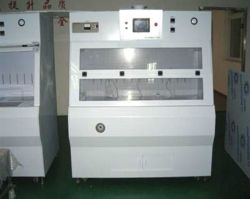Plasma Etching
| Price : | Price Negotiable |
| Quantity : | 100 () |
| Minimum Order : | 1 |
| Product Status : | New |
| Sample Available : | yes |
| Payment Mode : |
Bank Transfer |
| Categories : | Electrical & Electronics, Manufacturing Equipment for Electrical & Electronic Product |
| Posted By : | Suzhou Cse Semiconductor Equipment Technology Co., Ltd |
Description
Plasma etching, a purely chemical dry etching technique, basically consists of the following steps: 1) generation of reactive species in a plasma; 2) diffusion of these species to the surface of the material being etched; 3) adsorption of these species on the surface; 4) occurrence of chemical reactions between the species and the material being etched, forming volatile byproducts; 5) desorption of the byproducts from the surface; and 6) diffusion of the desorbed byproducts into the bulk of the gas.
Note that the desorption of the reaction byproducts from the surface of the material being plasma etched is just as important as the occurrence of the chemical reactions that consume the material. If such desorption fails to occur, then etching can not take place even if the chemical reactions have been completed. Thus, all the steps above must occur for the plasma etching process to be successful.
The selectivity of the species used in dry etching that employs chemical reactions is very important. Selectivity refers to the ability of the reactive species to etch away only the material intended for removal, while leaving all other materials intact. In particular, the species used must not attack the mask material over the material being etched as well as the material beneath it.
In general, the reactive species used in dry chemical etching must be selected so that the following criteria are met: 1) high selectivity against etching the mask material over the layer being etched; 2) high selectivity against etching the material under the layer being etched; 3) high etch rate for the material being removed; and 4) excellent etching uniformity. They should also allow a safe, clean, and automation-ready etching process.
Another important consideration in any etching process is its anisotropy, or property of etching in one direction only. A completely anisotropic etching process that removes material in the vertical direction only is very desirable, since it will follow the mask patterns on the wafer very faithfully, leaving any material covered by mask material basically untouched.
 |
|


